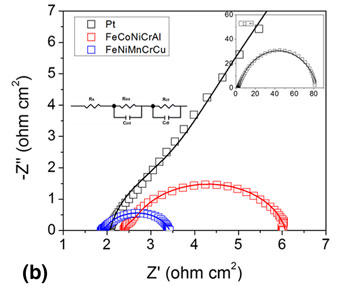Crossref Citations
This article has been cited by the following publications. This list is generated based on data provided by
Crossref.
Waag, Friedrich
Li, Yao
Ziefuß, Anna Rosa
Bertin, Erwan
Kamp, Marius
Duppel, Viola
Marzun, Galina
Kienle, Lorenz
Barcikowski, Stephan
and
Gökce, Bilal
2019.
Kinetically-controlled laser-synthesis of colloidal high-entropy alloy nanoparticles.
RSC Advances,
Vol. 9,
Issue. 32,
p.
18547.
Zeng, Libin
Chen, Shuai
van der Zalm, Joshua
Li, Xinyong
and
Chen, Aicheng
2019.
Sulfur vacancy-rich N-doped MoS2 nanoflowers for highly boosting electrocatalytic N2 fixation to NH3 under ambient conditions.
Chemical Communications,
Vol. 55,
Issue. 51,
p.
7386.
Chaugule, Avinash A.
Mane, Vishwanath S.
Bandal, Harshad A.
Kim, Hern
and
Kumbhar, Avinash S.
2019.
Ionic Liquid-Derived Co3O4-N/S-Doped Carbon Catalysts for the Enhanced Water Oxidation.
ACS Sustainable Chemistry & Engineering,
Vol. 7,
Issue. 17,
p.
14889.
Bose, Ranjith
Jothi, Vasanth Rajendiran
Karuppasamy, K.
Alfantazi, Akram
and
Yi, Sung Chul
2020.
High performance multicomponent bifunctional catalysts for overall water splitting.
Journal of Materials Chemistry A,
Vol. 8,
Issue. 27,
p.
13795.
Oses, Corey
Toher, Cormac
and
Curtarolo, Stefano
2020.
High-entropy ceramics.
Nature Reviews Materials,
Vol. 5,
Issue. 4,
p.
295.
Liu, Jinlong
Zhang, Tierui
and
Waterhouse, Geoffrey I. N.
2020.
Complex alloy nanostructures as advanced catalysts for oxygen electrocatalysis: from materials design to applications.
Journal of Materials Chemistry A,
Vol. 8,
Issue. 44,
p.
23142.
Ashok, Anchu
Kumar, Anand
Ponraj, Janarthanan
and
Mansour, Said A.
2020.
Preparation of Mesoporous/Microporous MnCo2O4 and Nanocubic MnCr2O4 Using a Single Step Solution Combustion Synthesis for Bifunction Oxygen Electrocatalysis.
Journal of The Electrochemical Society,
Vol. 167,
Issue. 5,
p.
054507.
Sukkurji, Parvathy Anitha
Cui, Yanyan
Lee, Seunghwa
Wang, Kai
Azmi, Raheleh
Sarkar, Abhishek
Indris, Sylvio
Bhattacharya, Subramshu S.
Kruk, Robert
Hahn, Horst
Wang, Qingsong
Botros, Miriam
and
Breitung, Ben
2021.
Mechanochemical synthesis of novel rutile-type high entropy fluorides for electrocatalysis.
Journal of Materials Chemistry A,
Vol. 9,
Issue. 14,
p.
8998.
Huang, Jian
Wang, Peilin
Li, Peng
Yin, Huayi
and
Wang, Dihua
2021.
Regulating electrolytic Fe0.5CoNiCuZn high entropy alloy electrodes for oxygen evolution reactions in alkaline solution.
Journal of Materials Science & Technology,
Vol. 93,
Issue. ,
p.
110.
Ma, Yanjiao
Ma, Yuan
Wang, Qingsong
Schweidler, Simon
Botros, Miriam
Fu, Tongtong
Hahn, Horst
Brezesinski, Torsten
and
Breitung, Ben
2021.
High-entropy energy materials: challenges and new opportunities.
Energy & Environmental Science,
Vol. 14,
Issue. 5,
p.
2883.
Hassan, Nur Hudawiyah Abu
Natsir, Nisa Syukrina Mat
Rahman, Siti Noramira Ab
Daud, Farah Diana Mohd
Jamal, Nur Ayuni
Ibrahim, NorFadhilah
and
Nordin, Norhuda Hidayah
2021.
Development of High Entropy Alloy (HEA) as Catalyst for Azo Dye Degradation in Fenton Process.
Journal of Physics: Conference Series,
Vol. 2129,
Issue. 1,
p.
012101.
Zhou, Daojin
Li, Pengsong
Lin, Xiao
McKinley, Adam
Kuang, Yun
Liu, Wen
Lin, Wen-Feng
Sun, Xiaoming
and
Duan, Xue
2021.
Layered double hydroxide-based electrocatalysts for the oxygen evolution reaction: identification and tailoring of active sites, and superaerophobic nanoarray electrode assembly.
Chemical Society Reviews,
Vol. 50,
Issue. 15,
p.
8790.
Ipadeola, Adewale K.
Haruna, Aderemi B.
Gaolatlhe, Lesego
Lebechi, Augustus K.
Meng, Jiashen
Pang, Quanquan
Eid, Kamel
Abdullah, Aboubakr M.
and
Ozoemena, Kenneth I.
2021.
Efforts at Enhancing Bifunctional Electrocatalysis and Related Events for Rechargeable Zinc‐Air Batteries.
ChemElectroChem,
Vol. 8,
Issue. 21,
p.
3998.
Huang, Jian
Du, Kaifa
Wang, Peilin
Yin, Huayi
and
Wang, Dihua
2021.
Electrochemical preparation and homogenization of face-centered FeCoNiCu medium entropy alloy electrodes enabling oxygen evolution reactions.
Electrochimica Acta,
Vol. 378,
Issue. ,
p.
138142.
Zhang, Kexin
and
Zou, Ruqiang
2021.
Advanced Transition Metal‐Based OER Electrocatalysts: Current Status, Opportunities, and Challenges.
Small,
Vol. 17,
Issue. 37,
Rawat, R.
Tiwari, A.
Arun, N.
Nageswara Rao, S.V.S.
Pathak, A.P.
Shadangi, Yagnesh
Mukhopadhyay, N.K.
Rao, S. Venugopal
and
Tripathi, A.
2021.
Nanosecond pulsed laser ablation of Al–Cu–Fe quasicrystalline material: Effects of solvent and fluence.
Journal of Alloys and Compounds,
Vol. 859,
Issue. ,
p.
157871.
Sun, Yifan
and
Dai, Sheng
2021.
High-entropy materials for catalysis: A new frontier.
Science Advances,
Vol. 7,
Issue. 20,
Sivanantham, Arumugam
Lee, Hansung
Hwang, Sung Won
Ahn, Byungmin
and
Cho, In Sun
2021.
Preparation, electrical and electrochemical characterizations of CuCoNiFeMn high-entropy-alloy for overall water splitting at neutral-pH.
Journal of Materials Chemistry A,
Vol. 9,
Issue. 31,
p.
16841.
Chen, Yuwei
Fu, Haoyu
Huang, Yangyang
Huang, Liqiang
Zheng, Xueying
Dai, Yiming
Huang, Yunhui
and
Luo, Wei
2021.
Opportunities for High-Entropy Materials in Rechargeable Batteries.
ACS Materials Letters,
Vol. 3,
Issue. 2,
p.
160.
Li, Hongdong
Lai, Jianping
Li, Zhenjiang
and
Wang, Lei
2021.
Multi‐Sites Electrocatalysis in High‐Entropy Alloys.
Advanced Functional Materials,
Vol. 31,
Issue. 47,
